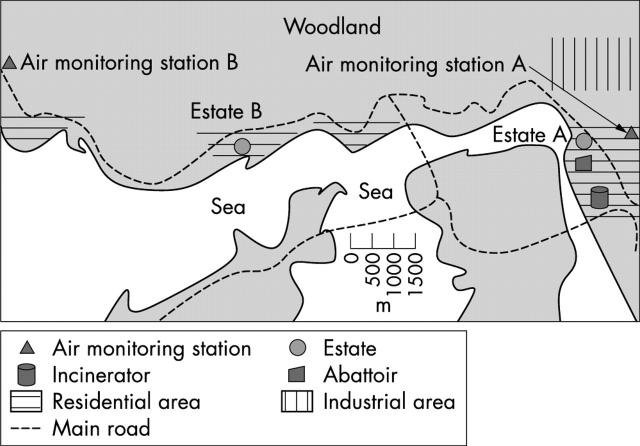Abstract
Aims: To explore the association of household gas cooking and respiratory illnesses in preschool children and their relation to outdoor air pollution.
Methods: Cross-sectional study among households that used gas stoves for cooking in two housing estates with contrasting air qualities in Hong Kong. A structured questionnaire was administered to parents of 426 children aged 0–6 years on their exposure to gas cooking and passive smoking, and the prevalence of respiratory illnesses.
Results: A total of 111 children (26.1%) were reported to have one or more respiratory illnesses (allergic rhinitis, asthma, bronchitis, sinusitis, and pneumonia). Of these, 21 (18.9%), 41 (36.9%), and 49 (44.1%) children were from households that cooked once, twice, and three times a day with gas. Hierarchical logistic regression models adjusting for socioeconomic, demographic, and indoor risk factors including passive smoking showed that household gas cooking was positively associated with respiratory illnesses. There was a dose-response relation between the frequency of gas cooking and the prevalence of respiratory illnesses in the estate with lower outdoor air pollution (OR = 6.1 and 3.2 respectively, for cooking three and two meals a day, compared to one meal a day). This relation was not observed in the more polluted estate. The association between the presence of a cigarette smoker in the household and the prevalence of respiratory illnesses was not significant.
Conclusions: As gas cooking is common in urban households, the findings could have important public health implications.
Full Text
The Full Text of this article is available as a PDF (212.5 KB).
Figure 1.
Location of the two estates and air monitoring stations.
Selected References
These references are in PubMed. This may not be the complete list of references from this article.
- Awasthi S., Glick H. A., Fletcher R. H. Effect of cooking fuels on respiratory diseases in preschool children in Lucknow, India. Am J Trop Med Hyg. 1996 Jul;55(1):48–51. doi: 10.4269/ajtmh.1996.55.48. [DOI] [PubMed] [Google Scholar]
- Comstock G. W., Meyer M. B., Helsing K. J., Tockman M. S. Respiratory effects on household exposures to tobacco smoke and gas cooking. Am Rev Respir Dis. 1981 Aug;124(2):143–148. doi: 10.1164/arrd.1981.124.2.143. [DOI] [PubMed] [Google Scholar]
- Dennekamp M., Howarth S., Dick C. A., Cherrie J. W., Donaldson K., Seaton A. Ultrafine particles and nitrogen oxides generated by gas and electric cooking. Occup Environ Med. 2001 Aug;58(8):511–516. doi: 10.1136/oem.58.8.511. [DOI] [PMC free article] [PubMed] [Google Scholar]
- Farrow A., Greenwood R., Preece S., Golding J. Nitrogen dioxide, the oxides of nitrogen, and infants' health symptoms. ALSPAC Study Team. Avon Longitudinal Study of Pregnancy and Childhood. Arch Environ Health. 1997 May-Jun;52(3):189–194. doi: 10.1080/00039899709602885. [DOI] [PubMed] [Google Scholar]
- Garrett M. H., Hooper M. A., Hooper B. M., Abramson M. J. Respiratory symptoms in children and indoor exposure to nitrogen dioxide and gas stoves. Am J Respir Crit Care Med. 1998 Sep;158(3):891–895. doi: 10.1164/ajrccm.158.3.9701084. [DOI] [PubMed] [Google Scholar]
- Goren A. I., Hellmann S. Respiratory conditions among schoolchildren and their relationship to environmental tobacco smoke and other combustion products. Arch Environ Health. 1995 Mar-Apr;50(2):112–118. doi: 10.1080/00039896.1995.9940888. [DOI] [PubMed] [Google Scholar]
- Hölscher B., Heinrich J., Jacob B., Ritz B., Wichmann H. E. Gas cooking, respiratory health and white blood cell counts in children. Int J Hyg Environ Health. 2000 Mar;203(1):29–37. doi: 10.1078/S1438-4639(04)70005-X. [DOI] [PubMed] [Google Scholar]
- Jarvis D., Chinn S., Luczynska C., Burney P. Association of respiratory symptoms and lung function in young adults with use of domestic gas appliances. Lancet. 1996 Feb 17;347(8999):426–431. doi: 10.1016/s0140-6736(96)90009-4. [DOI] [PubMed] [Google Scholar]
- Jarvis D., Chinn S., Sterne J., Luczynska C., Burney P. The association of respiratory symptoms and lung function with the use of gas for cooking. European Community Respiratory Health Survey. Eur Respir J. 1998 Mar;11(3):651–658. [PubMed] [Google Scholar]
- Munyard P., Bush A. How much coughing is normal? Arch Dis Child. 1996 Jun;74(6):531–534. doi: 10.1136/adc.74.6.531. [DOI] [PMC free article] [PubMed] [Google Scholar]
- Stein R. T., Holberg C. J., Sherrill D., Wright A. L., Morgan W. J., Taussig L., Martinez F. D. Influence of parental smoking on respiratory symptoms during the first decade of life: the Tucson Children's Respiratory Study. Am J Epidemiol. 1999 Jun 1;149(11):1030–1037. doi: 10.1093/oxfordjournals.aje.a009748. [DOI] [PubMed] [Google Scholar]
- Ware J. H., Dockery D. W., Spiro A., 3rd, Speizer F. E., Ferris B. G., Jr Passive smoking, gas cooking, and respiratory health of children living in six cities. Am Rev Respir Dis. 1984 Mar;129(3):366–374. doi: 10.1164/arrd.1984.129.3.366. [DOI] [PubMed] [Google Scholar]
- Wieringa M., Weyler J., Vermeire P. Absence of association between respiratory symptoms in young adults and use of gas stoves in Belgium. Lancet. 1996 May 25;347(9013):1490–1491. doi: 10.1016/s0140-6736(96)91729-8. [DOI] [PubMed] [Google Scholar]



